The Home Improvement Blog by Slide-Lok Garage Interiors
Concrete Coating Adhesion Pull-Off Strength Test (ASTM D4541)
Adhesion pull-off strength testing is used to determine the overall quality of a coating system, to evaluate the integrity of an installed system and its potential performance.
10/7/2021
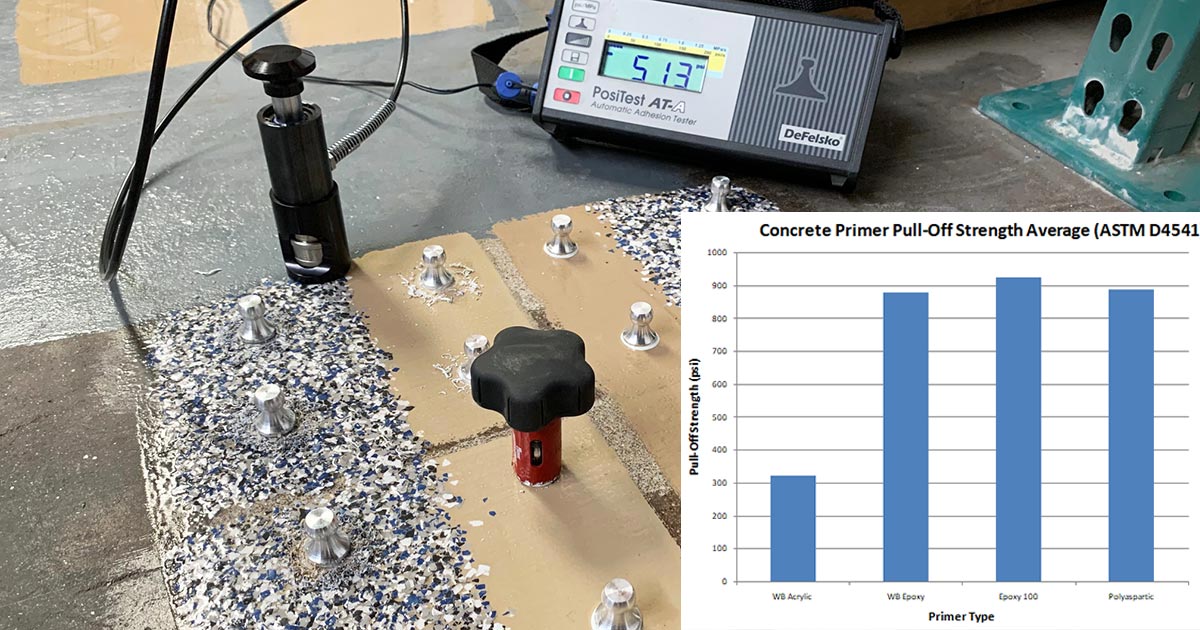
Adhesion testing is an integral part in developing concrete coating systems, even though it is just one of many reasons a coating may fail prematurely. Coating systems typically comprise of a primer or base, a build or chip coat, and a topcoat. Concrete floor coatings are offered as systems to ensure consistent quality in line with the manufacturers published data. Adhesion pull-off strength testing is invaluable in determining the overall quality and integrity of an installed system and its potential performance or lack thereof.
Concrete is well known to have high compressive strength, typically in the 2500-4000 psi range and frequently exhibits low tensile strength around 400-500 psi. It's hardly surprising then, that most concrete coating adhesion pull-off strength testing exhibits substrate failure in the 400-500 psi range. The majority of coatings Slide-Lok manufactures for distribution fall into this category, where the adhesion pull-off strength tests show the substrate failing before the coating.
Slide-Lok is a coatings manufacturer that offers specific coating systems that meet specific in-house testing requirements. Slide-Lok does not recommend mixing and matching different coating materials without supporting test data. The order in which the materials are applied does indeed matter! Cutting corners to save a few dollars will ultimately lead to the contractor installing an inferior product, resulting in callbacks to jobs for repairs or replacement.
Acrylic Primer Coating System Adhesion Study
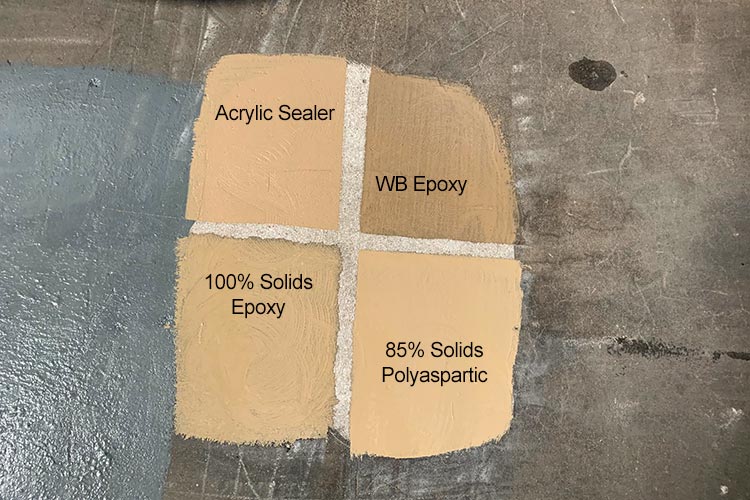
Prime coat over diamond ground concrete.
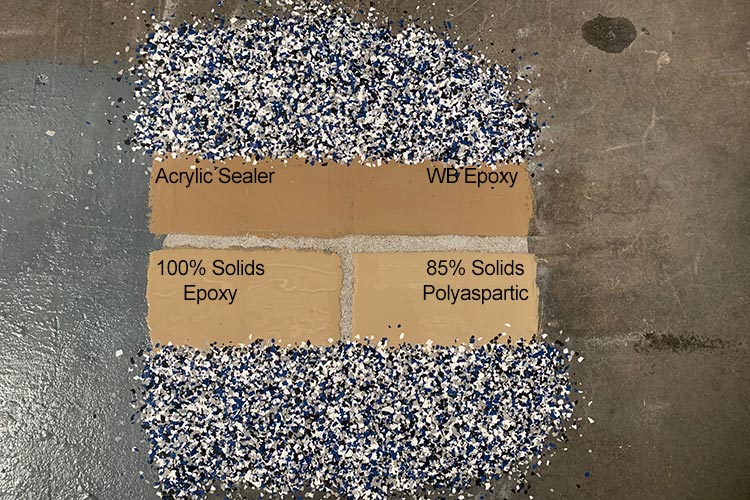
2nd coat with chips.
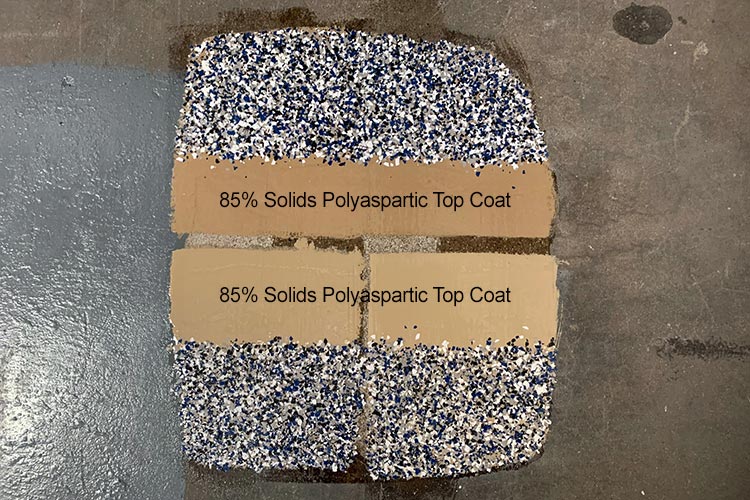
Polyaspartic Top Coat.
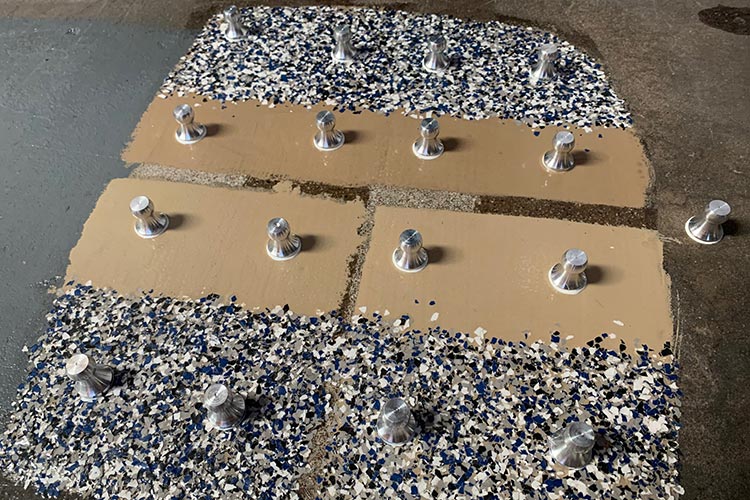
20mm test dollies glued to substrate.
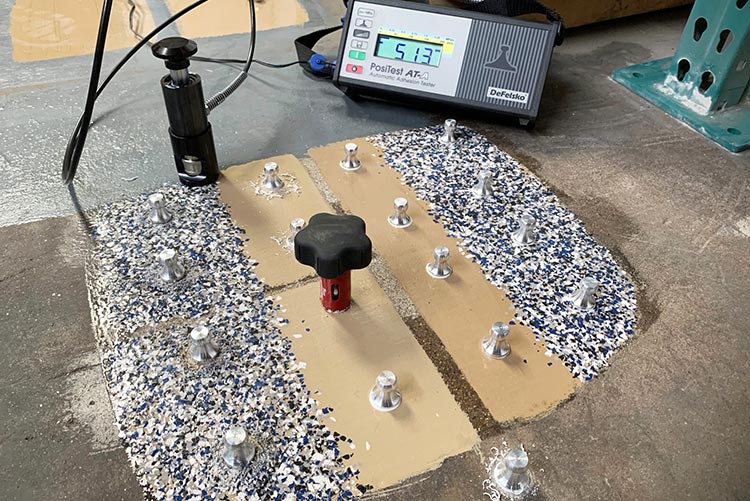
DeFelsko PosiTest AT-A Adhesion tester and cutter/scoring device.
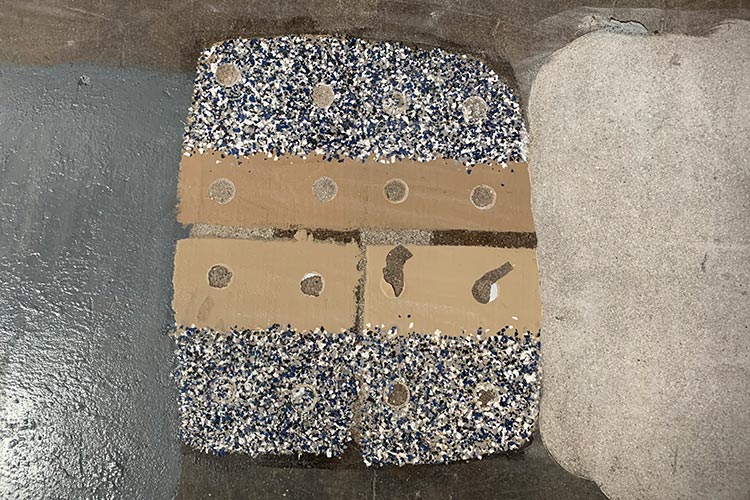
After pulling the 20mm test dollies.
A coatings contractor approached Slide-Lok and explained that they have been installing a waterborne acrylic sealer as the primer followed with a waterborne epoxy and a polyaspartic top coat at the recommendation of another manufacturer in the floor coating industry. The contractor expressed interest in this system due to lower material cost for the acrylic sealer/primer and fast dry time between the primer and the waterborne epoxy chip layer. They wanted to know if this is a system Slide-Lok would also recommend. The answer to this question would require some time to do the required testing:
"I can run an adhesion study based on the acrylic primer system you are using to compare against other coating systems. Gathering quantitative data is the best way to determine if this system will be on-par with the systems you plan on replacing them with."
Samuel Strayer, Chemist
Design of Experiment
The coating adhesion pull-off strength experiment was designed in a way to evaluate the experimental coating system the contractor inquired about vs Slide-Lok's standard floor coating systems. The same substrate was used for each coating system, the substrate was diamond grinded to a similar profile, and the coating layers were applied at the same times. This limited differences in temperature, humidity, substrate, and applicator. To limit the adhesion pull area to be directly underneath the dolly the coating material was lightly scored/cut around the dolly.
Focused directly on the strength of the primer it was determined that lightly cutting/scoring around the dolly to remove excess 3M adhesive used to glue the dolly to the substrate would result in more accurate data. Even though the ASTM D4541 standard states "Scoring around the fixture violates the fundamental test criterion that an unaltered coating be tested. If scoring around the test surface is employed, extreme care is required to prevent micro cracking in the coating, since cracks may cause failures at diminished strengths. Scored samples constitute a different test, and this procedure should be reported with the results". Scoring/cutting around the dolly improves upon the standard and makes this a more accurate test, negating the elasticity and tensile strength of excess 3M adhesive used to glue the dolly to the coating.
Adhesion Pull-Off Strength Results
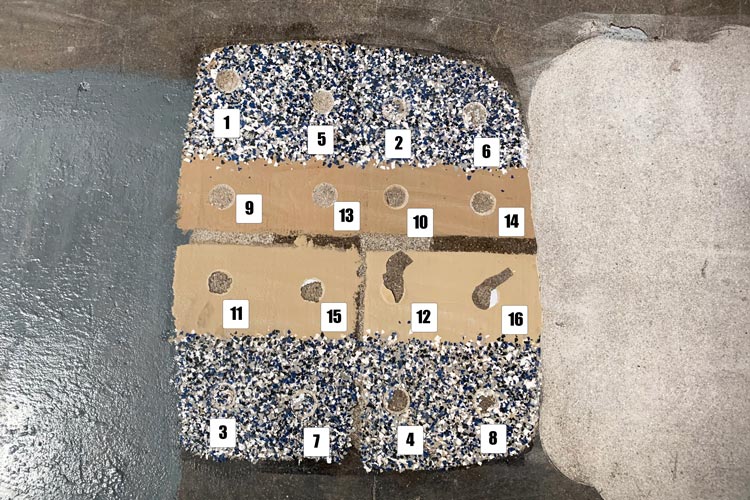
Looking at the results from the face of the dollies and the pull location you can begin to see that not all coating systems are created equally. The face of the dolly and the pull location tell a story unique to each adhesion pull. It is important to evaluate each individual pull to determine if the failure point is at the substrate, within the coating itself or at the glue/dolly interface. Recording this information and comparing it with the pull-off strength pressure provides a good picture as to the overall quality of a coating system.
Control Dolly - 513 psi

Any good study requires a control. This 20mm dolly was applied adjacent the coating test square. The adhesion pull-off strength of the dolly glued directly to the concrete substrate should be a good representation of the tensile strength of the concrete being tested. This specific dolly pulled off at 513 psi. Notice that the face of the dolly is not perfectly smooth, the concrete gave and there are uneven pieces on the face of the dolly inline with a substrate failure. With the control in the appropriate range you are able to compare it to the pull-off strength of the coating systems in this study.
Waterborne Acrylic Sealer / Primer — 321 psi (primer failure)
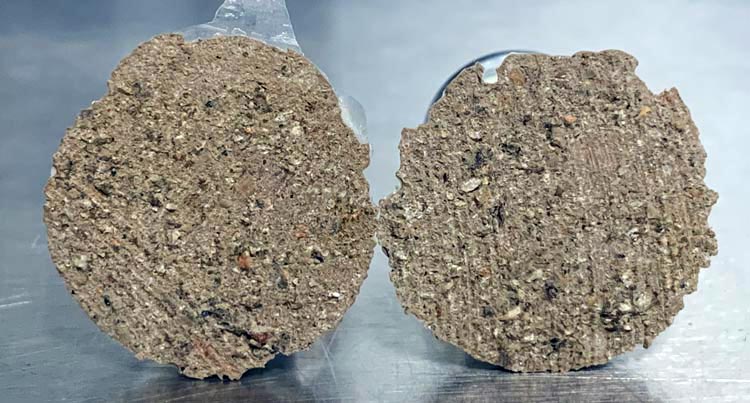
Acrylic sealer concrete primer system pull-off results averaged 321 psi. Failure at the substrate.
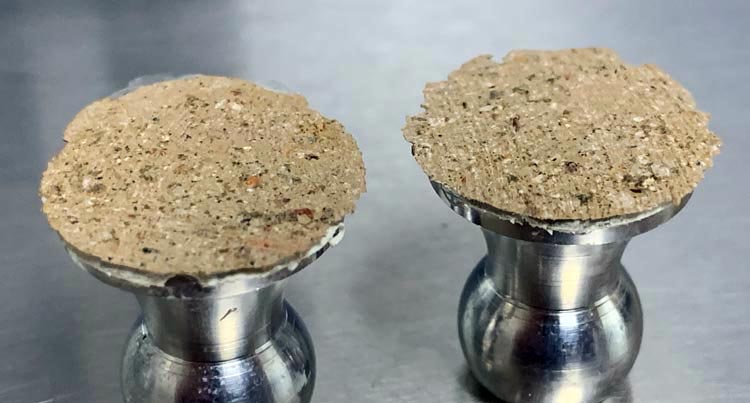
Acrylic sealer concrete primer system pull-off results averaged 321 psi. Failure at the substrate.
The first coating system, top left quadrant of the test square, is comprised of a waterborne acrylic sealer/primer, waterborne epoxy pigmented/chip coat and polyaspartic top coat. The average adhesion pull-off strength for the acrylic primer system was 321 psi. Roughly 19.75%-35.8% less than the typical tensile strength of concrete (400-500 psi), or 37.42% less than the control dolly (513 psi). The dolly face appears to have minimal concrete on it and it is very smooth, the pull location shows no residual coating and no concrete crater indicating the concrete did not break or go with the dolly. This would be considered an adhesive failure between the primer and the substrate. The pull-off strength of the acrylic primer system is well below the typical tensile strength of the concrete substrate. The acrylic sealer / primer system failed to "bite" into the substrate.
Waterborne Epoxy Primer — 881 psi (substrate failure)
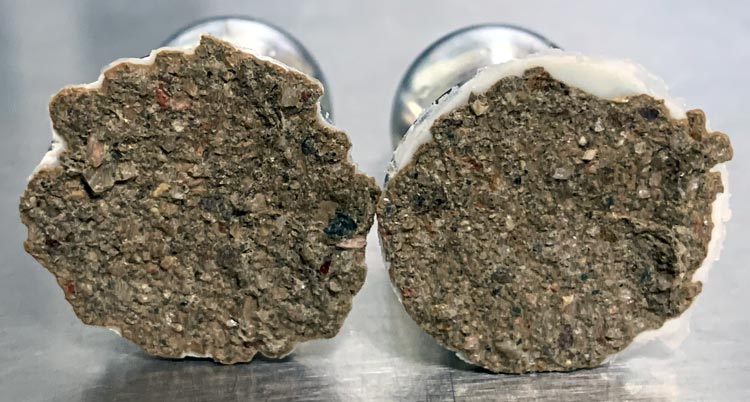
Waterborne epoxy primer system pull-off results averaged 881 psi. Failure at the substrate.
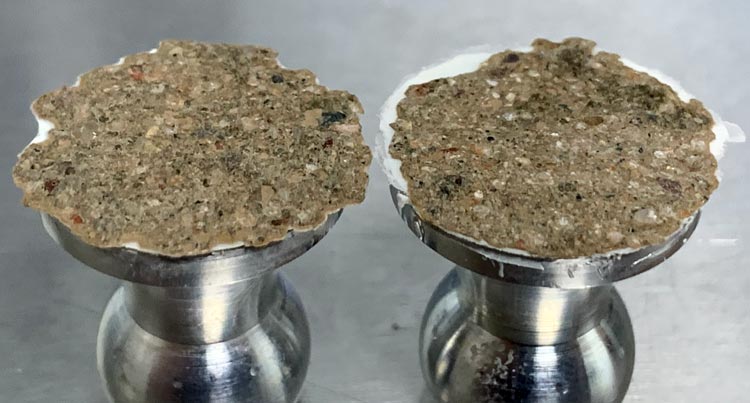
Waterborne epoxy primer system pull-off results averaged 881 psi. Failure at the substrate.
The second coating system, top right quadrant of the test square, is comprised of a waterborne epoxy primer, waterborne epoxy pigmented/chip coat and polyaspartic top coat. The average adhesion pull-off strength for the waterborne epoxy primer system was 881 psi. This is an excellent pull-off number, which is approximately 176-220% greater than the typical tensile strength of concrete (400-500 psi), or 171.7% greater than the control dolly (513 psi). The dolly face has chunks of concrete on it, it is quite rough and uneven, and the pull location shows no residual coating. This would be considered a substrate failure. The pull-off strength of this coating far exceeded the tensile strength of concrete, the result of the coating penetrating the substrate actually strengthened it.
Epoxy 100 Primer — 925 psi (substrate failure)

Solventborne epoxy 100 coating system pull-off results averaged 925 psi. Failure at the substrate.
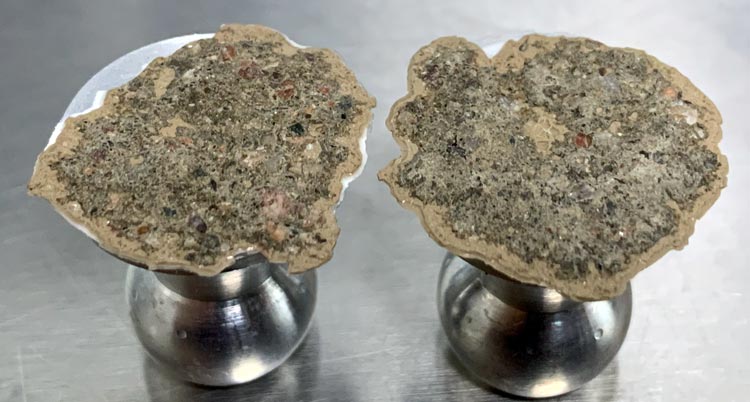
Solventborne epoxy 100 coating system pull-off results averaged 925 psi. Failure at the substrate.
The third coating system, bottom left quadrant of the test square, is comprised of a 100% solids solvent reducible epoxy primer, 100% solids epoxy pigmented/chip coat and polyaspartic top coat. The average adhesion pull-off strength for the 100% solids epoxy primer system was 925 psi. This is an excellent pull-off number, which is approximately 185-231% greater than the typical tensile strength of concrete (400-500 psi), or 180.3% greater than the control dolly (513 psi). The dolly face has chunks of concrete on it, it is quite rough and uneven, and the pull location shows less than 10% residual coating. This would be considered a substrate failure. The pull-off strength of this coating far exceeded the tensile strength of concrete, the result of the epoxy coating penetrating the substrate actually strengthened it.
Polyaspartic Primer — 891 psi (Glue failure)
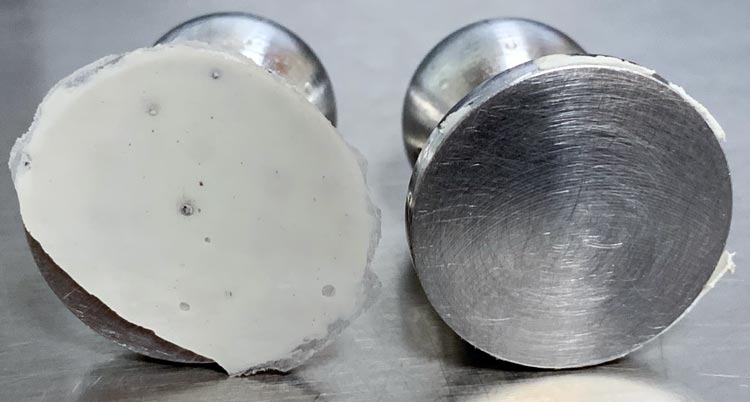
85% solids polyaspartic coating system pull-off results averaged 891 psi. Failure at Adhesive/Glue interface.
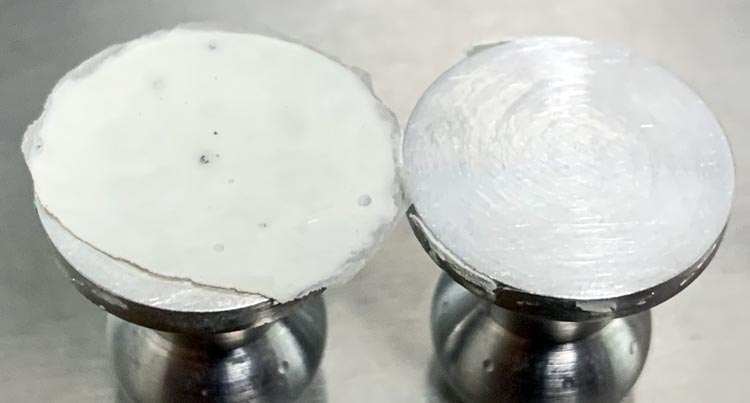
85% solids polyaspartic coating system pull-off results averaged 891 psi. Failure at Adhesive/Glue interface.
The fourth coating system, bottom right quadrant of the test square, is comprised of a 85% solids polyaspartic primer, 85% solids polyaspartic pigmented/chip coat and polyaspartic top coat. The average adhesion pull-off strength for the 85% solids polyaspartic primer system was 891 psi. This is an excellent pull-off number, which is approximately 178-222% greater than the typical tensile strength of concrete (400-500 psi), or 173.68% greater than the control dolly (513 psi). One dolly face shows the 3M adhesive and another shows a clean dolly face, this is quite an interesting pull because the dolly adhesive failed in both. This would be considered a coating/glue failure at the surface. The pull-off strength at the time of the failure is in-line with the past two coating systems (WB epoxy and epoxy 100), and exceeded the tensile strength of concrete. The result of the polyaspartic coating penetrating the substrate actually strengthened it, otherwise it would have failed much earlier around 500 psi.
It's surprising to see this type of failure because it rarely occurs, and is likely adhesion failure due to contamination at the dolly face or between the glue and the dolly or the coating and we can see one of each occured. One dolly experienced a failure between the glue and the coating and the other between the dolly and the glue. At the time of failure the force also caused the coating to pull from the substrate at the primer and substrate level. It occured in both pulls at 862 psi and 920 psi, respectively. After careful inspection of the substrate pull locations and peeling back the coating it is determined that the adhesion pull-off numbers will represent this sample since the substrate interface had pulled off slightly at the conclusiong of the initial pull. Had the glue not failed, it is not believed the sample would have exceeded 1000 psi.
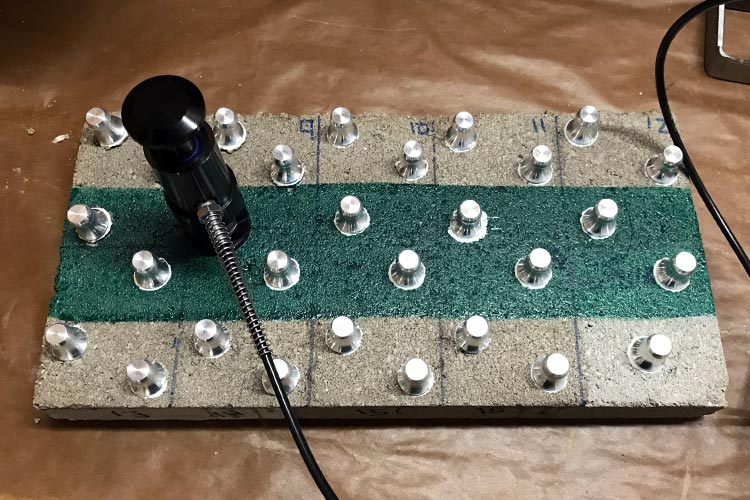
Extensive adhesion testing has been conducted using the 85% solids polyaspartic coating system. The adhesion pull off strength of the polyaspartic published in its data sheet is 900 psi and acceptable results can vary by as much as 10% or more depending on the substrate used. For example, prior susbtrate testing using concrete blocks found at a local hardware store resulted in much higher readings. Concrete blocks like the one pictured above are extremely porous, allowing the coating to penetrate further than it normally would in a more typical concrete floor. Adhesion testing from concrete blocks like this can result in pull-off strength numbers in the 1000-1500+ psi range. Testing on porous concrete blocks produce extraordinary numbers and introduce bias in testing. Not only is the test method important, but so is the substrate being used for the test.
Conclusion: Floor Coating Systems Play An Important Role In Adhesion
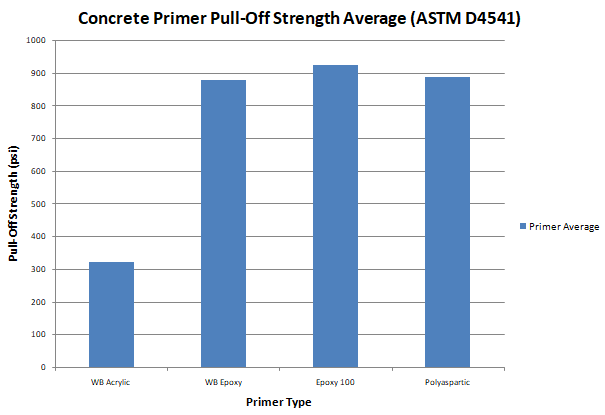
This study was aimed at evaluating the adhesion pull-off strengths of different coating systems on a concrete substrate. Selection of the right floor coating system does indeed play a role in adhesion to concrete. Rather, the solution is in selecting an appropriate primer. The first coating layer of a coating system is probably the most important as it is the layer that bonds directly to the substrate. The acrylic sealer in this study was dry to the touch in 30 minutes and did not penetrate the concrete nearly as well as all of the other systems in the study. The failure of the acrylic primer at an average pull-off strength of 321 psi is on average 64.3% less than the pull-off strength of the three other systems in the study.
While adhesion testing is not an indicator of how long a coating will survive it is a good indicator as to the overall quality of a flooring system. Comparative testing like this is useful because the other systems in the study have been used for decades on hundreds of thousands of floors. Slide-Lok's contractor network installs tens of thousands of floors every year. Flooring failures are few and far between; however, when they do occur the overwhelming majority can be attibuted to applicator/mixing error, improper substrate preparation and/or water mitigation issues. It goes without saying that it would be unwise to purposefully choose a coating system with a primer that has an adhesion pull-off strength that is 64.3% less than that of the other coatings that are readily available today.
In more layman's terms... Is saving a few dollars on materials worth it? Worth the risk of being called back to fix a job? Worth the risk to your reputation?
Gallery: Concrete Coating System Adhesion Study
Note: Adhesion pull-off strength numbers are reported only for solid color floor coating systems. Chips and flakes within a coating system have a similar tensile strength to non-primed concrete and experience failure around 400-500 psi. In the acrylic primer system, the primer did not penetrate and the failure occured between the primer and the substrate at 321 psi. In every other system the primer penetrated the substrate and resulted in increased tensile strength at the substrate to around 900 psi; therefore, this results in the chip/flake layer failing first around 400-500 psi. Thus, numbers are only reported for the solid color coating systems showing the increase in tensile strength at the substrate. Measuring the difference between the pull-off strengths of the coating systems was the purpose of the study and that is only capable with the solid color flooring systems.
For More Information
Call Toll Free: 1-800-835-1759
Email Matt Thomas: matt.thomas@slide-lok.com
Slide-Lok Is The Most Trusted Name In Garage Makeovers Since 1977
Solid Products, Great Prices, and Timely Technical Support since 1977! Slide-Lok Garage Interiors is the oldest, longest continuing garage makeover brand in North America. We were the first one stop shop garage makeover for storage systems and flooring. We were also one of the first outfits to offer polyaspartic floor coatings to the residential garage flooring market. Our leading polyaspartic coatings have been in use on garage floors for nearly two decades, our competitors can't make that claim. We also manufacture and sell epoxy coatings that are great for indoor floors.
There are Authorized Slide-Lok Garage Flooring and Storage dealers all over the US and Canada that can transform your boring and dull garage into your dream garage. Every garage tells a different story, let us help tell yours.
So what are you waiting for, get your FREE ESTIMATE today: Contact Slide-Lok Garage Interiors.
Become a Slide-Lok Floor Coating & Garage Storage Dealer
Expand your contracting business, there are more opportunities when you carry Slide-Lok Garage Interior products. Slide-Lok is your one stop shop for garage flooring and storage solutions since 1977. Inquire today and discover the benefits of Slide-Lok Garage Interiors.
About The Author

Samuel Strayer is a trained chemist with a Bachelor of Science in Biochemistry from Arizona State University with an emphasis on material and polymer science. Samuel has been involved in developing and testing coating systems for over 10 years.
Keywords: concrete, coating, testing, adhesion, positest, defelsko, astm, d4541, pull, off, strength, polyaspartic, epoxy, acrylic, polyurethane, flooring
© Copyright, 2021, Slide-Lok (DBA), Mirabel Coatings Inc.
Back to Posts on The Home Improvement Blog
Contact Local Dealer
Find a Slide-Lok Garage Floor & Cabinet dealer in your area.
Call: 1-800-835-1759
E-mail: Click to e-mail.
Featured Blog Posts
- Concrete Coating System Adhesion Study
- We Want To Thank Our Suppliers!
- Closed July 2-5 for Independence Day
- Best Garage Floor Coatings in Phoenix, AZ
- New Flooring Chips and Flakes Brochure - Featuring 41 Colors!
- How To Choose The Right Color To Paint Your Garage
- 41 Stock Blends of Color Chips and Flakes for Floor Coatings
- 6 New Color Chips & Flakes for Floor Coatings
- Residential and Commercial Floor Coatings in Phoenix, Arizona
- 13 New Color Chips & Flakes for Floor Coatings
- 4 Home Improvement and Organizational Tips To Elevate Your Home
- Floor Coating Video
- Failed DIY Garage Floor Coating vs. Pro
- How To Get Smoother Top Coats, Chip and Flake Floor Coating Sealer
- Closed Labor Day Weekend Sept. 4-7
- Garage Floor Coating Transformation in Laramie, Wyoming
- Flooring Chips and Flakes Now Available By The Bucket
- Closed July 3-6 For Independence Day
- Fighting Allergies During COVID-19
- Become An Authorized Slide-Lok Floor Coating and Storage Installer
- Inventory Levels and Lead Times - Impacted Supply Chains
- Flooring Chips and Flakes Brochures
- Waterborne Epoxy Garage Floor Coating Training Video
- SBA Paycheck Protection Program - CARES ACT
- Spring Cleaning During Coronavirus Pandemic
- Staying Healthy: How To Minimize Your Risks Of Catching The Coronavirus (COVID-19)
- We Are Open, Taking & Shipping Orders
- When To Paint Your House - 5 Useful Tips For Interior Painting
- 10 Ideas For Your Garage Makeover
- Surviving WOC 2020: Coronavirus (COVID-19)
- The Best Time Of Year To Paint The Exterior Of Your Home
- Two Tone Chip Epoxy Floor in Mesa, Arizona
- Fitness Center Gets Metallic Epoxy Floor Coating
- Western Coating Societies Symposium and Show 2019
- Polyurea Is Better Than Polyaspartic?
- How To Improve Your Home's Curb Appeal
- 2 Tone Garage Floor Coating in Omaha, Nebraska
- Colorado Springs Garage Floor Restoration
- Polyaspartic Coating Survives as Boat Deck Coating
- Best Wasp & Hornet Pesticide Spray From Home Depot 2019
- Polyaspartic Flooring Withstands Flooding in Austin, Texas
- Garage Makeovers Shine in Florida
- Best Garage Remodels in Phoeniz, AZ
- Best Garage Makeovers of South Carolina
- Best Floor Coatings for Auto Mechanic Shops
- Garage Floor Coating Install in Anderson, IN
- DIY Epoxy Coating Repair in Casper, WY
- Polyaspartic Garage Floor Install in Pittsburgh, PA
- Garage Flooring & Painting in Omaha, Nebraska
- Concrete Coating Install in Eagan, Minnesota
- Garage Cabinet Installation in Wyoming, Michigan
- Garage Floor Coatings Albany, IN
Contact Local Dealer
Find a Slide-Lok Garage Floor & Cabinet dealer in your area.
Call: 1-800-835-1759
E-mail: Click to e-mail.
Featured Blog Posts
- Concrete Coating System Adhesion Study
- We Want To Thank Our Suppliers!
- Closed July 2-5 for Independence Day
- Best Garage Floor Coatings in Phoenix, AZ
- New Flooring Chips and Flakes Brochure - Featuring 41 Colors!
- How To Choose The Right Color To Paint Your Garage
- 41 Stock Blends of Color Chips and Flakes for Floor Coatings
- 6 New Color Chips & Flakes for Floor Coatings
- Residential and Commercial Floor Coatings in Phoenix, Arizona
- 13 New Color Chips & Flakes for Floor Coatings
- 4 Home Improvement and Organizational Tips To Elevate Your Home
- Floor Coating Video
- Failed DIY Garage Floor Coating vs. Pro
- How To Get Smoother Top Coats, Chip and Flake Floor Coating Sealer
- Closed Labor Day Weekend Sept. 4-7
- Garage Floor Coating Transformation in Laramie, Wyoming
- Flooring Chips and Flakes Now Available By The Bucket
- Closed July 3-6 For Independence Day
- Fighting Allergies During COVID-19
- Become An Authorized Slide-Lok Floor Coating and Storage Installer
- Inventory Levels and Lead Times - Impacted Supply Chains
- Flooring Chips and Flakes Brochures
- Waterborne Epoxy Garage Floor Coating Training Video
- SBA Paycheck Protection Program - CARES ACT
- Spring Cleaning During Coronavirus Pandemic
- Staying Healthy: How To Minimize Your Risks Of Catching The Coronavirus (COVID-19)
- We Are Open, Taking & Shipping Orders
- When To Paint Your House - 5 Useful Tips For Interior Painting
- 10 Ideas For Your Garage Makeover
- Surviving WOC 2020: Coronavirus (COVID-19)
- The Best Time Of Year To Paint The Exterior Of Your Home
- Two Tone Chip Epoxy Floor in Mesa, Arizona
- Fitness Center Gets Metallic Epoxy Floor Coating
- Western Coating Societies Symposium and Show 2019
- Polyurea Is Better Than Polyaspartic?
- How To Improve Your Home's Curb Appeal
- 2 Tone Garage Floor Coating in Omaha, Nebraska
- Colorado Springs Garage Floor Restoration
- Polyaspartic Coating Survives as Boat Deck Coating
- Best Wasp & Hornet Pesticide Spray From Home Depot 2019
- Polyaspartic Flooring Withstands Flooding in Austin, Texas
- Garage Makeovers Shine in Florida
- Best Garage Remodels in Phoeniz, AZ
- Best Garage Makeovers of South Carolina
- Best Floor Coatings for Auto Mechanic Shops
- Garage Floor Coating Install in Anderson, IN
- DIY Epoxy Coating Repair in Casper, WY
- Polyaspartic Garage Floor Install in Pittsburgh, PA
- Garage Flooring & Painting in Omaha, Nebraska
- Concrete Coating Install in Eagan, Minnesota
- Garage Cabinet Installation in Wyoming, Michigan
- Garage Floor Coatings Albany, IN

